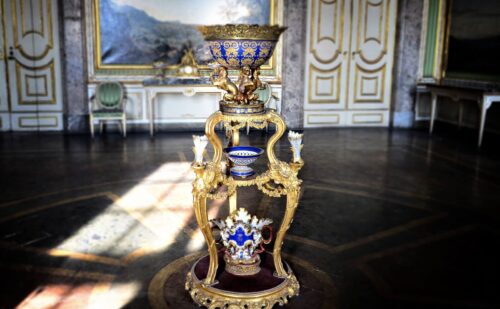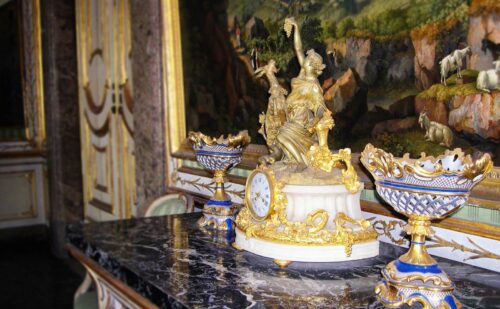The Hall of Spring was the Antechamber for the Audiences
In the Hall of Spring guests waited to be received by the King
Description
The Hall of Spring was the Antechamber for the Audiences , so it served as a waiting room where guests waited to be received in the Audience Hall next door.
The Hall of Spring is frescoed with “The Triumph of Spring” by Antonio Dominici, completed in 1787. At the time it was identified as the “First antechamber at noon”.

The Hall
Decorations and furnishings of the Antechamber
The fresco of Spring
In Dominici’s Springthe reawakening of life is represented as a garden from which one can glimpse vegetable arcades and balconies with spectators observing the room, musicians playing and angels preparing the party by flying to weave garlands of flowers. In the center with a perspective effect and sitting on the clouds is Spring crowned by angels with a garland.
Curiosity: garlands began to be widely used in decoration after the discoveries of Herculaneum and Pompeii.
Paintings
The paintings in the room were created from 1784 to 1799 by the German landscape painter Jacob Phillip Hackert specifically for this room:
- The launch of the Partenope in 1786;
- Shipyard of Castellammare with the launching of a vessel;
- Foria of Ischia;
- The passage of the squad sent to Algiers;
- The Neapolitan fleet setting sail for Toulon;
the port and the abbey of Gaeta;
The overdoors and over-mirrors were painted, in the same period, by Giovan Battista Rossi, with allegories depicting: the Opera, the Poetry, the Tragic and Pastoral and the Epic. The overmirrors depict Apollo, god of the arts and sciences, and Orpheus, protector of Music.
Furnishings
The walls are covered with silks from the royal silk factories of San Leucio, and the boiseries were created by Gennaro Fiore and Bartolomeo Natale.
The consoles are projects by the architect Carlo Vanvitelli, son of Luigi Vanvitelli, and are emblematic of his classicist style but with a Rococo imprint: by stylizing the typically Rococo arched legs, and simplifying the shape of the whole, he gives it a modern and classicist style. The typically Neapolitan white and gold color further underlines its simple and modern lines. Even the chairs are transitional in style, albeit Rococo in style, the truncated pyramid legs show that another style was being born, the Neoclassical.
These pieces of furniture can be dated between 1796 and 1798 since they are listed in the Inventory of 1799, even if in 1806 they will be transported to Sicily, where they appear in the inventory drawn up in Palermo”.
The fireplace is in gray Mondragone marble and was executed by the sculptor Gaetano Salomone, who will take care, with his workers, of the plastic decoration of the Royal Apartment.
The mobile furniture is completed by a mid-19th century planter made up of a gilded, carved and hundreds wooden tripod with six painted porcelain vases bearing the monogram of King Ferdinand II.
The chandelier is in Murano glass with glass paste flowers.
This room exemplifies the style of the transition period between the Rococo and the Neoclassical.
Neo-baroque planter in gilded wood in the shape of a tripod, with porcelain on which, in one case, there is the monogram of King Ferdinand II.
External Link








